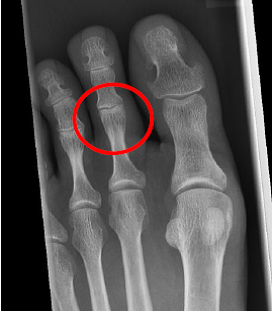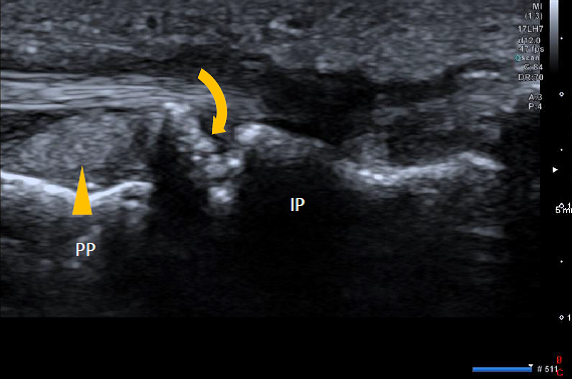Case 6: Occult Fracture of the 2nd Toe in a runner
A 40 year old male runner presented to Ultrasound with a referral from their GP with pain in the forefoot. Problems had been present for 3 weeks. Onset had been gradual during a run. There was no reported trauma. The patient described not being able to run with pain also affecting walking.
There were no other reported medical problems.
The patient was a regular runner and had not recently changed their running programme although had recently changed his running shoes to a relatively un-supportive shoe from their normal ‘motion-control’ shoe type.
The referral was for ‘Morton’s Neuroma?’
The ankle and foot presented in a mildly pronated position in standing. Range of movement in the foot was pain-free. Power was full. There was tenderness with Mulder’s click test but no ‘click’. Tenderness was elicited with direct palpation of the proximal interphalangeal joint of the 2nd toe.
Previous x-rays were unremarkable.

Ultrasound failed to demonstrate any evidence of a Morton’s neuroma. However, imaging the plantar aspect of proximal interphalangeal joint of the 2nd toe demonstrated significant cortical irregularity at the base of the intermediate phalanx. There was some fluid and soft tissue swelling around the flexor tendon however testing demonstrated a patent tendon. With dynamic assessment the cortical fragment appeared stable and attached to the plantar plate of the joint. Findings in keeping with an avulsion fracture of the base of the intermediate phalanx.

Longitudinal view of the proximal interphalangeal joint of the 2nd toe. PP–proximal phalanx; IP–intermediate phalanx; Curved arrow-avulsion fragment; Arrowhead-plantar plate.
